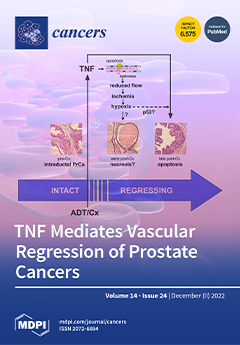Although the prognosis of tonsillar cancer (human papillomavirus-positive oropharyngeal squamous cell carcinoma) is improving, disease control failure (distant metastasis) still occurs in some cases. We explored whether several
18F-fluorodeoxyglucose (FDG) positron-emission tomography (PET) parameters can predict metastasis. We retrospectively reviewed the medical records of 55 patients with tonsil squamous cell carcinoma who underwent pretreatment
18F-FDG positron-emission tomography/computed tomography (PET/CT) followed by primary surgery. During the follow-up period, systemic metastases were found in 7 of the 55 patients. The most common sites were the lungs (33%), bone (22%), brain/skull base (22%), small bowel (11%), and liver (11%). Pathologically, P53 mutation was less common in patients with systemic metastasis (41.7% vs. 14.3%,
p = 0.054) than without systemic metastasis. In terms of PET parameters, the metabolic tumor volume (MTV
2.5) and total lesion glycolysis (TLG
2.5) values were lower in the primary tumor, and higher in the metastatic lymph nodes, of human papillomavirus (HPV)-positive compared to HPV-negative patients (all
p < 0.05). The MTV
2.5, TLG
2.5, and tumor–to–liver uptake ratio were 36.07 ± 54.24 cm
3, 183.46 ± 298.62, and 4.90 ± 2.77, respectively, in the systemic metastasis group, respectively; all of these values were higher than those of the patients without systemic metastasis (all
p < 0.05). The MTV
2.5 value was significantly different between the groups even when the values for the primary tumor and metastatic lymph nodes were summed (53.53 ± 57.78 cm
3,
p = 0.036). The cut-off value, area under the curve (95% confidence interval), sensitivity, and specificity of MTV
2.5 for predicting systemic metastasis were 11.250 cm
3, 0.584 (0.036–0.832), 0.571, and 0.565, respectively. The MTV
2.5 of metastatic lymph nodes and summed MTV
2.5 values of the primary tumor and metastatic lymph nodes were significantly higher in tonsillar cancer patients with than without systemic metastases. We suggest PET/CT scanning for pre-treatment cancer work-up and post-treatment surveillance to consider additional systemic therapy in patients with a high risk of disease control failure.
Full article






